An Introduction to Palliative Care: Pain Management and Nursing Role
VerifiedAdded on 2021/02/20
|12
|3046
|32
Essay
AI Summary
This essay provides an introduction to palliative care, emphasizing pain management as a critical aspect of end-of-life care. It defines palliative care as an interdisciplinary approach focused on relieving physical and mental stress in patients with life-limiting illnesses. The essay explores the background of pain management, categorizing different types of pain and highlighting the significance of pain assessment. It delves into various palliative management strategies, including pharmacological interventions like corticosteroids, antidepressants, and opioids, as well as non-drug approaches such as relaxation techniques, massage therapy, and physiotherapy. The role of nurses, doctors, and other healthcare professionals in pain management is also discussed. Furthermore, the essay examines the role of supportive interventions, such as physiotherapy and cognitive behavior therapy, in enhancing patient comfort and quality of life. It underscores the importance of patient education and involvement in the care process.
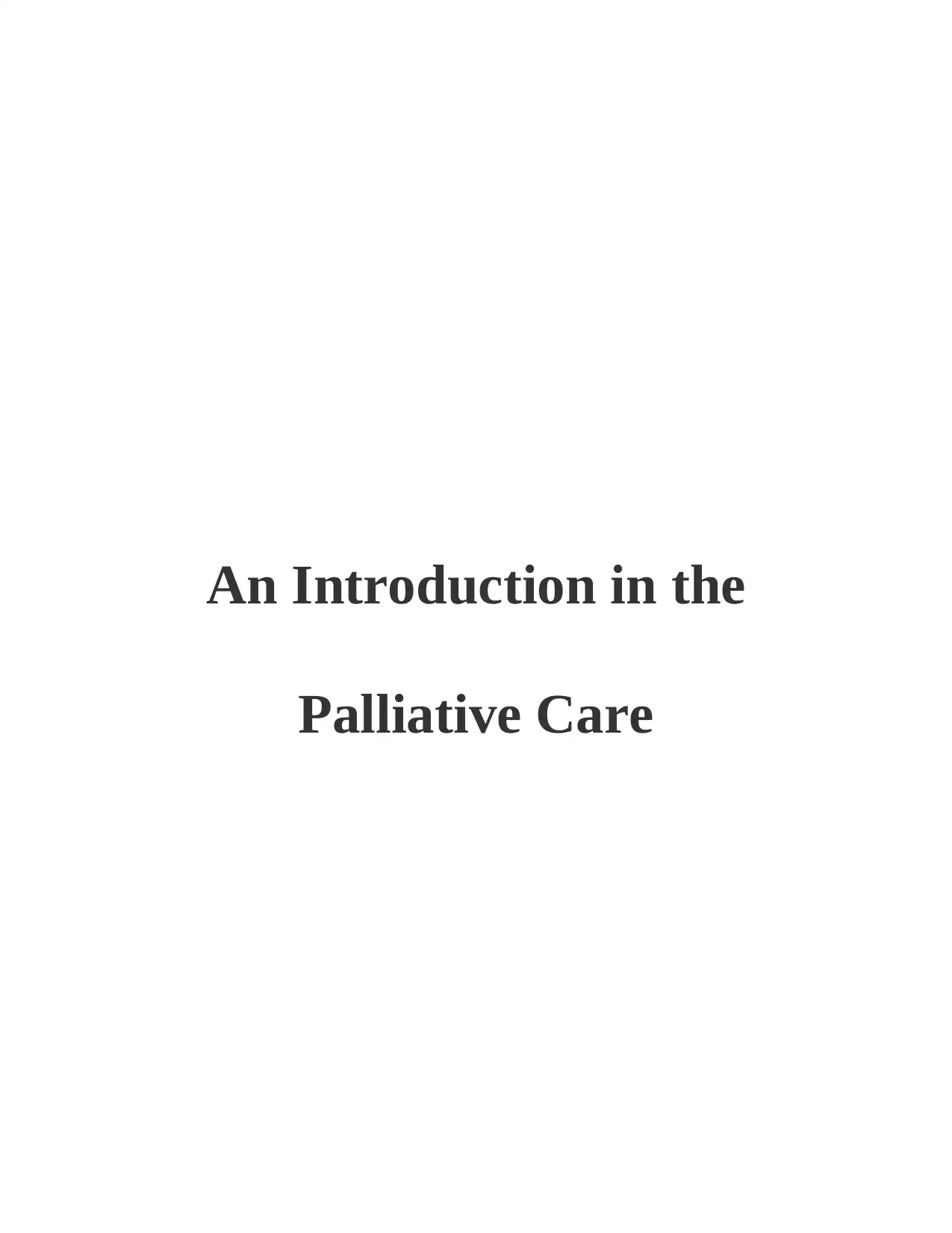
An Introduction in the
Palliative Care
Palliative Care
Paraphrase This Document
Need a fresh take? Get an instant paraphrase of this document with our AI Paraphraser
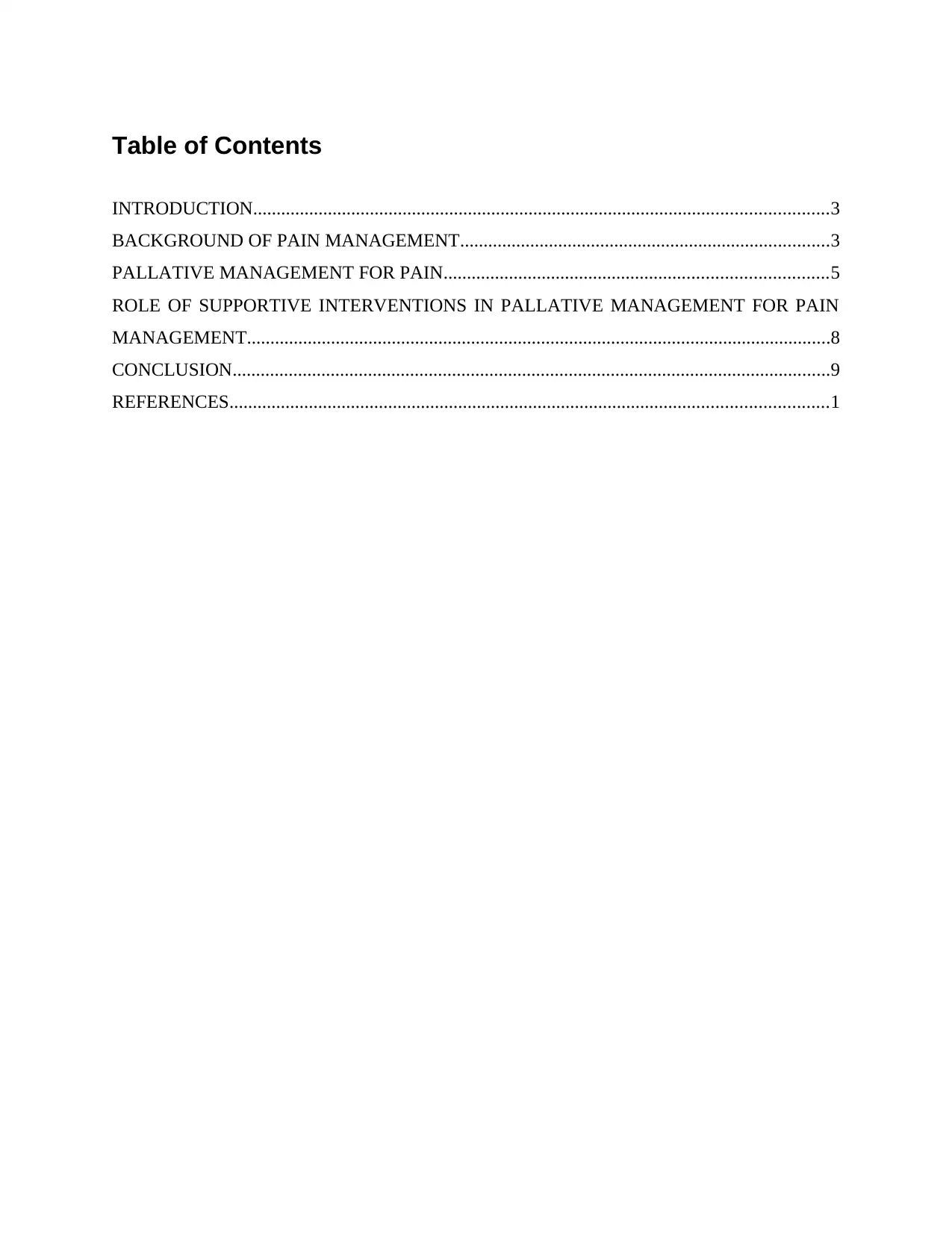
Table of Contents
INTRODUCTION...........................................................................................................................3
BACKGROUND OF PAIN MANAGEMENT...............................................................................3
PALLATIVE MANAGEMENT FOR PAIN..................................................................................5
ROLE OF SUPPORTIVE INTERVENTIONS IN PALLATIVE MANAGEMENT FOR PAIN
MANAGEMENT.............................................................................................................................8
CONCLUSION................................................................................................................................9
REFERENCES................................................................................................................................1
INTRODUCTION...........................................................................................................................3
BACKGROUND OF PAIN MANAGEMENT...............................................................................3
PALLATIVE MANAGEMENT FOR PAIN..................................................................................5
ROLE OF SUPPORTIVE INTERVENTIONS IN PALLATIVE MANAGEMENT FOR PAIN
MANAGEMENT.............................................................................................................................8
CONCLUSION................................................................................................................................9
REFERENCES................................................................................................................................1
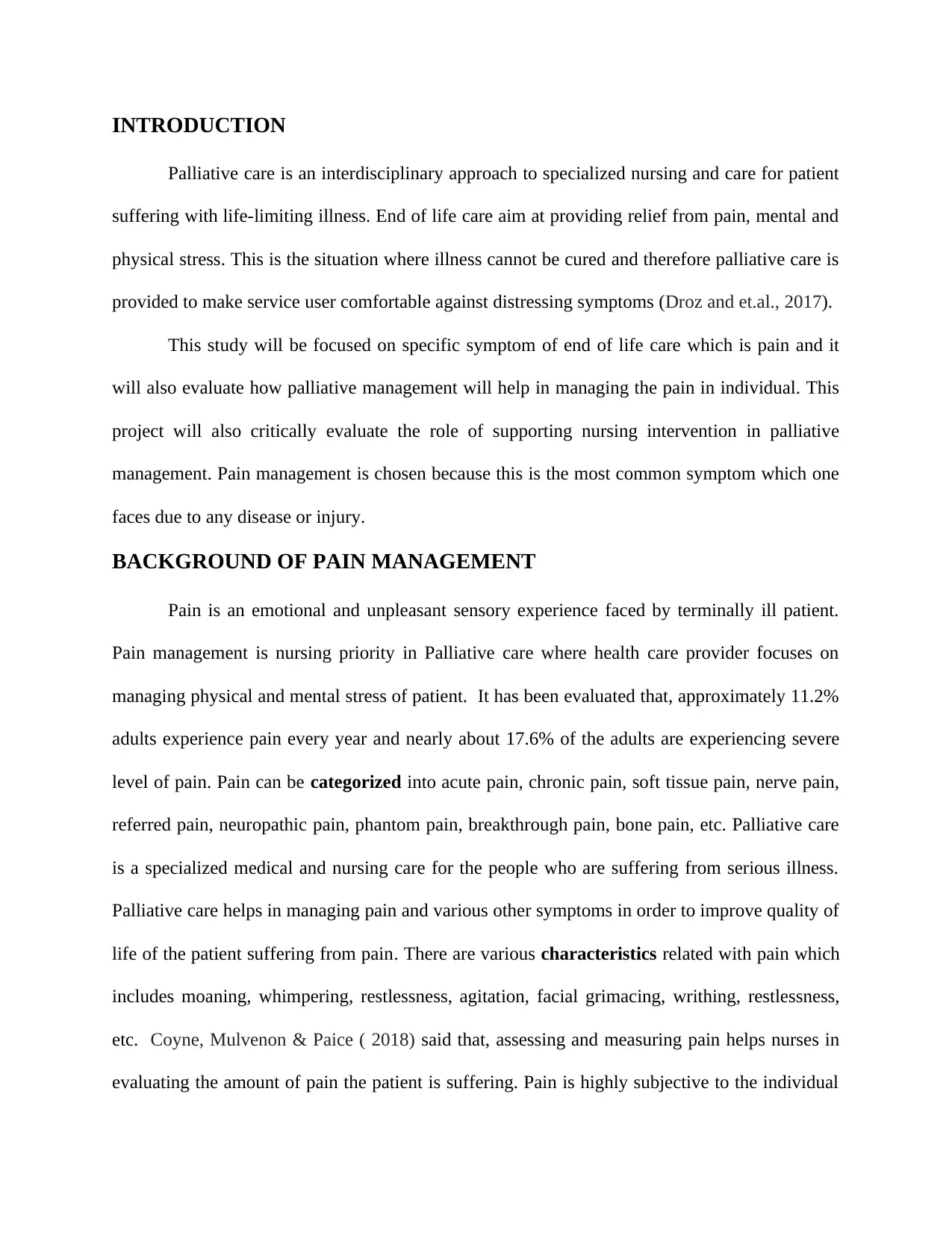
INTRODUCTION
Palliative care is an interdisciplinary approach to specialized nursing and care for patient
suffering with life-limiting illness. End of life care aim at providing relief from pain, mental and
physical stress. This is the situation where illness cannot be cured and therefore palliative care is
provided to make service user comfortable against distressing symptoms (Droz and et.al., 2017).
This study will be focused on specific symptom of end of life care which is pain and it
will also evaluate how palliative management will help in managing the pain in individual. This
project will also critically evaluate the role of supporting nursing intervention in palliative
management. Pain management is chosen because this is the most common symptom which one
faces due to any disease or injury.
BACKGROUND OF PAIN MANAGEMENT
Pain is an emotional and unpleasant sensory experience faced by terminally ill patient.
Pain management is nursing priority in Palliative care where health care provider focuses on
managing physical and mental stress of patient. It has been evaluated that, approximately 11.2%
adults experience pain every year and nearly about 17.6% of the adults are experiencing severe
level of pain. Pain can be categorized into acute pain, chronic pain, soft tissue pain, nerve pain,
referred pain, neuropathic pain, phantom pain, breakthrough pain, bone pain, etc. Palliative care
is a specialized medical and nursing care for the people who are suffering from serious illness.
Palliative care helps in managing pain and various other symptoms in order to improve quality of
life of the patient suffering from pain. There are various characteristics related with pain which
includes moaning, whimpering, restlessness, agitation, facial grimacing, writhing, restlessness,
etc. Coyne, Mulvenon & Paice ( 2018) said that, assessing and measuring pain helps nurses in
evaluating the amount of pain the patient is suffering. Pain is highly subjective to the individual
Palliative care is an interdisciplinary approach to specialized nursing and care for patient
suffering with life-limiting illness. End of life care aim at providing relief from pain, mental and
physical stress. This is the situation where illness cannot be cured and therefore palliative care is
provided to make service user comfortable against distressing symptoms (Droz and et.al., 2017).
This study will be focused on specific symptom of end of life care which is pain and it
will also evaluate how palliative management will help in managing the pain in individual. This
project will also critically evaluate the role of supporting nursing intervention in palliative
management. Pain management is chosen because this is the most common symptom which one
faces due to any disease or injury.
BACKGROUND OF PAIN MANAGEMENT
Pain is an emotional and unpleasant sensory experience faced by terminally ill patient.
Pain management is nursing priority in Palliative care where health care provider focuses on
managing physical and mental stress of patient. It has been evaluated that, approximately 11.2%
adults experience pain every year and nearly about 17.6% of the adults are experiencing severe
level of pain. Pain can be categorized into acute pain, chronic pain, soft tissue pain, nerve pain,
referred pain, neuropathic pain, phantom pain, breakthrough pain, bone pain, etc. Palliative care
is a specialized medical and nursing care for the people who are suffering from serious illness.
Palliative care helps in managing pain and various other symptoms in order to improve quality of
life of the patient suffering from pain. There are various characteristics related with pain which
includes moaning, whimpering, restlessness, agitation, facial grimacing, writhing, restlessness,
etc. Coyne, Mulvenon & Paice ( 2018) said that, assessing and measuring pain helps nurses in
evaluating the amount of pain the patient is suffering. Pain is highly subjective to the individual
⊘ This is a preview!⊘
Do you want full access?
Subscribe today to unlock all pages.

Trusted by 1+ million students worldwide
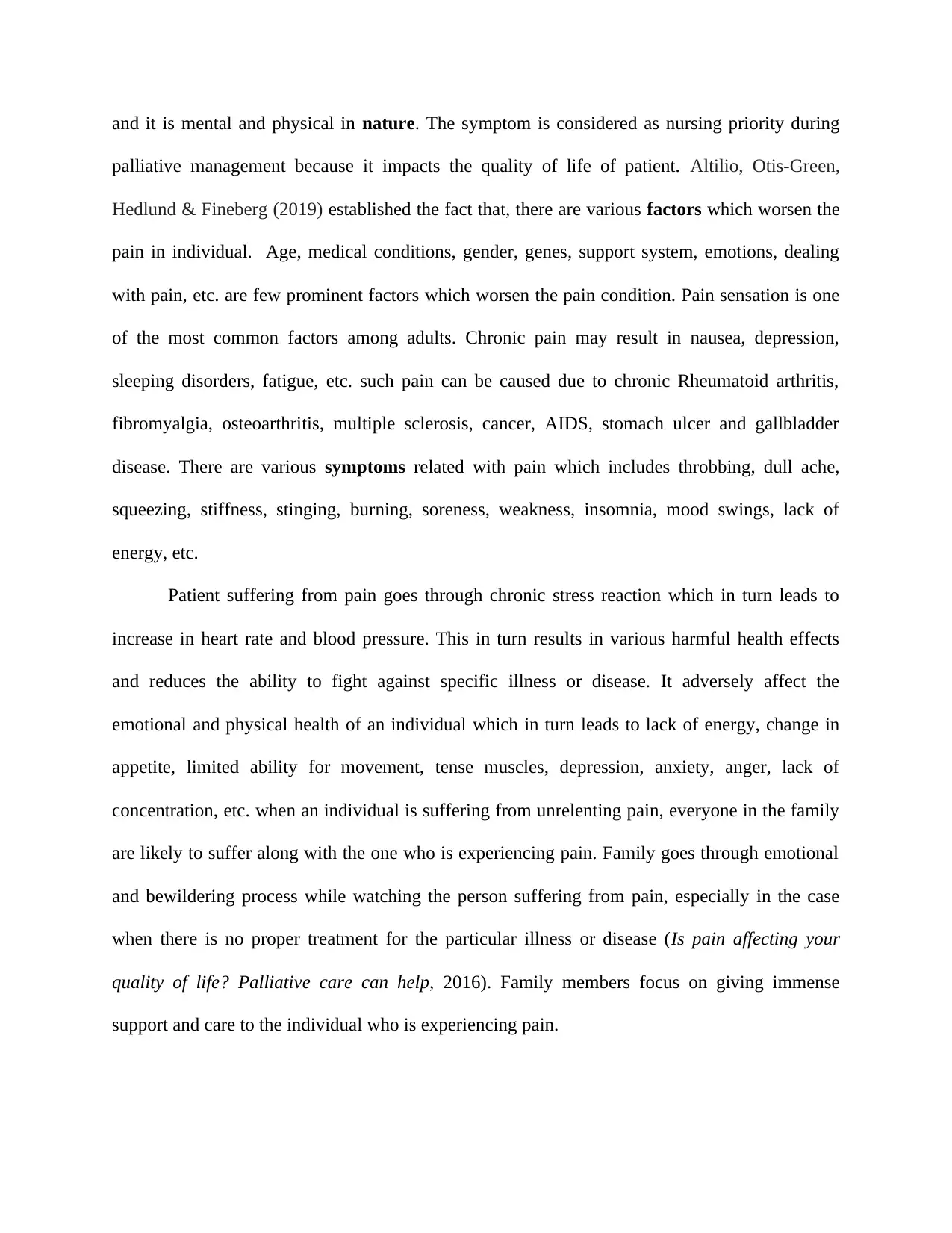
and it is mental and physical in nature. The symptom is considered as nursing priority during
palliative management because it impacts the quality of life of patient. Altilio, Otis‐Green,
Hedlund & Fineberg (2019) established the fact that, there are various factors which worsen the
pain in individual. Age, medical conditions, gender, genes, support system, emotions, dealing
with pain, etc. are few prominent factors which worsen the pain condition. Pain sensation is one
of the most common factors among adults. Chronic pain may result in nausea, depression,
sleeping disorders, fatigue, etc. such pain can be caused due to chronic Rheumatoid arthritis,
fibromyalgia, osteoarthritis, multiple sclerosis, cancer, AIDS, stomach ulcer and gallbladder
disease. There are various symptoms related with pain which includes throbbing, dull ache,
squeezing, stiffness, stinging, burning, soreness, weakness, insomnia, mood swings, lack of
energy, etc.
Patient suffering from pain goes through chronic stress reaction which in turn leads to
increase in heart rate and blood pressure. This in turn results in various harmful health effects
and reduces the ability to fight against specific illness or disease. It adversely affect the
emotional and physical health of an individual which in turn leads to lack of energy, change in
appetite, limited ability for movement, tense muscles, depression, anxiety, anger, lack of
concentration, etc. when an individual is suffering from unrelenting pain, everyone in the family
are likely to suffer along with the one who is experiencing pain. Family goes through emotional
and bewildering process while watching the person suffering from pain, especially in the case
when there is no proper treatment for the particular illness or disease (Is pain affecting your
quality of life? Palliative care can help, 2016). Family members focus on giving immense
support and care to the individual who is experiencing pain.
palliative management because it impacts the quality of life of patient. Altilio, Otis‐Green,
Hedlund & Fineberg (2019) established the fact that, there are various factors which worsen the
pain in individual. Age, medical conditions, gender, genes, support system, emotions, dealing
with pain, etc. are few prominent factors which worsen the pain condition. Pain sensation is one
of the most common factors among adults. Chronic pain may result in nausea, depression,
sleeping disorders, fatigue, etc. such pain can be caused due to chronic Rheumatoid arthritis,
fibromyalgia, osteoarthritis, multiple sclerosis, cancer, AIDS, stomach ulcer and gallbladder
disease. There are various symptoms related with pain which includes throbbing, dull ache,
squeezing, stiffness, stinging, burning, soreness, weakness, insomnia, mood swings, lack of
energy, etc.
Patient suffering from pain goes through chronic stress reaction which in turn leads to
increase in heart rate and blood pressure. This in turn results in various harmful health effects
and reduces the ability to fight against specific illness or disease. It adversely affect the
emotional and physical health of an individual which in turn leads to lack of energy, change in
appetite, limited ability for movement, tense muscles, depression, anxiety, anger, lack of
concentration, etc. when an individual is suffering from unrelenting pain, everyone in the family
are likely to suffer along with the one who is experiencing pain. Family goes through emotional
and bewildering process while watching the person suffering from pain, especially in the case
when there is no proper treatment for the particular illness or disease (Is pain affecting your
quality of life? Palliative care can help, 2016). Family members focus on giving immense
support and care to the individual who is experiencing pain.
Paraphrase This Document
Need a fresh take? Get an instant paraphrase of this document with our AI Paraphraser
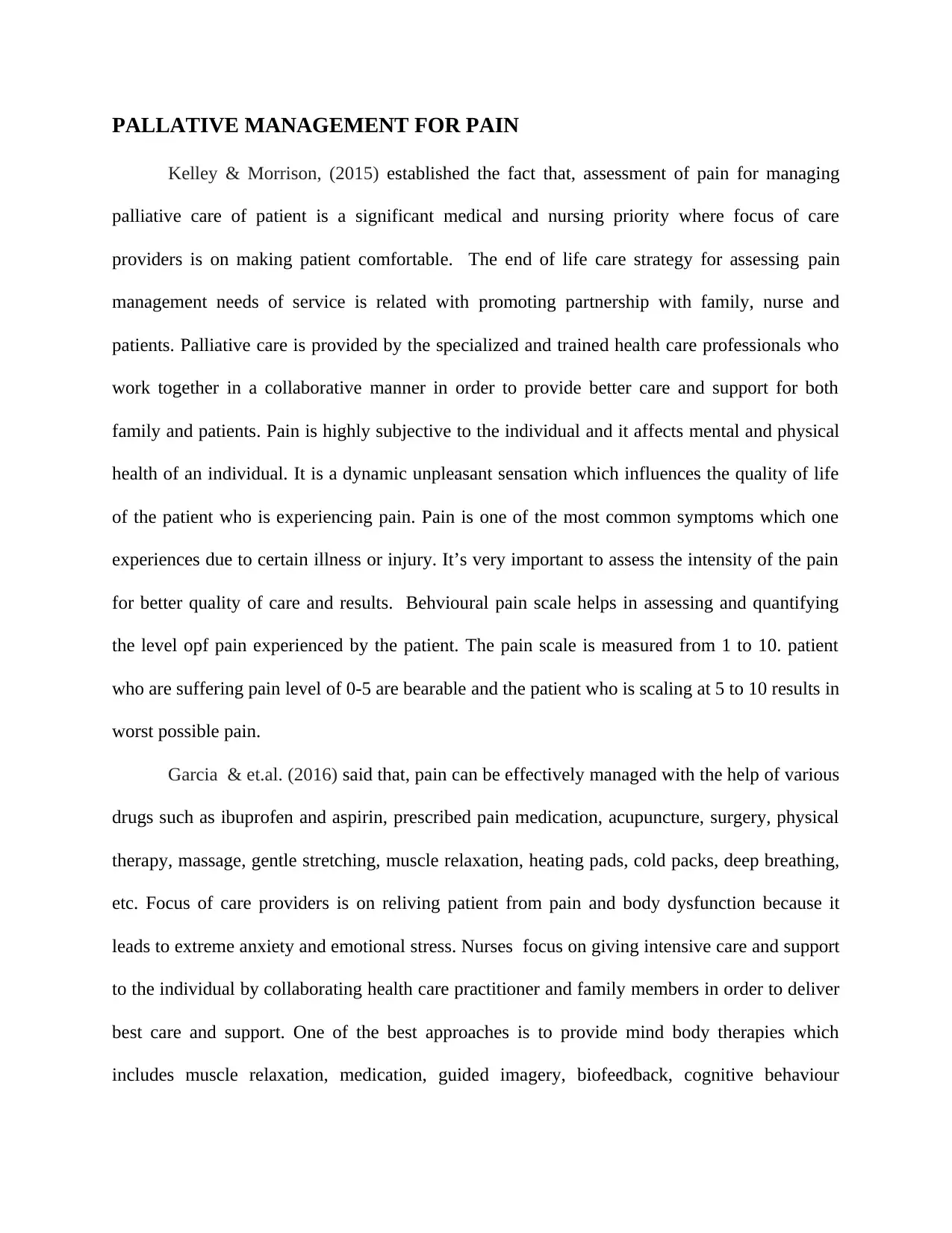
PALLATIVE MANAGEMENT FOR PAIN
Kelley & Morrison, (2015) established the fact that, assessment of pain for managing
palliative care of patient is a significant medical and nursing priority where focus of care
providers is on making patient comfortable. The end of life care strategy for assessing pain
management needs of service is related with promoting partnership with family, nurse and
patients. Palliative care is provided by the specialized and trained health care professionals who
work together in a collaborative manner in order to provide better care and support for both
family and patients. Pain is highly subjective to the individual and it affects mental and physical
health of an individual. It is a dynamic unpleasant sensation which influences the quality of life
of the patient who is experiencing pain. Pain is one of the most common symptoms which one
experiences due to certain illness or injury. It’s very important to assess the intensity of the pain
for better quality of care and results. Behvioural pain scale helps in assessing and quantifying
the level opf pain experienced by the patient. The pain scale is measured from 1 to 10. patient
who are suffering pain level of 0-5 are bearable and the patient who is scaling at 5 to 10 results in
worst possible pain.
Garcia & et.al. (2016) said that, pain can be effectively managed with the help of various
drugs such as ibuprofen and aspirin, prescribed pain medication, acupuncture, surgery, physical
therapy, massage, gentle stretching, muscle relaxation, heating pads, cold packs, deep breathing,
etc. Focus of care providers is on reliving patient from pain and body dysfunction because it
leads to extreme anxiety and emotional stress. Nurses focus on giving intensive care and support
to the individual by collaborating health care practitioner and family members in order to deliver
best care and support. One of the best approaches is to provide mind body therapies which
includes muscle relaxation, medication, guided imagery, biofeedback, cognitive behaviour
Kelley & Morrison, (2015) established the fact that, assessment of pain for managing
palliative care of patient is a significant medical and nursing priority where focus of care
providers is on making patient comfortable. The end of life care strategy for assessing pain
management needs of service is related with promoting partnership with family, nurse and
patients. Palliative care is provided by the specialized and trained health care professionals who
work together in a collaborative manner in order to provide better care and support for both
family and patients. Pain is highly subjective to the individual and it affects mental and physical
health of an individual. It is a dynamic unpleasant sensation which influences the quality of life
of the patient who is experiencing pain. Pain is one of the most common symptoms which one
experiences due to certain illness or injury. It’s very important to assess the intensity of the pain
for better quality of care and results. Behvioural pain scale helps in assessing and quantifying
the level opf pain experienced by the patient. The pain scale is measured from 1 to 10. patient
who are suffering pain level of 0-5 are bearable and the patient who is scaling at 5 to 10 results in
worst possible pain.
Garcia & et.al. (2016) said that, pain can be effectively managed with the help of various
drugs such as ibuprofen and aspirin, prescribed pain medication, acupuncture, surgery, physical
therapy, massage, gentle stretching, muscle relaxation, heating pads, cold packs, deep breathing,
etc. Focus of care providers is on reliving patient from pain and body dysfunction because it
leads to extreme anxiety and emotional stress. Nurses focus on giving intensive care and support
to the individual by collaborating health care practitioner and family members in order to deliver
best care and support. One of the best approaches is to provide mind body therapies which
includes muscle relaxation, medication, guided imagery, biofeedback, cognitive behaviour
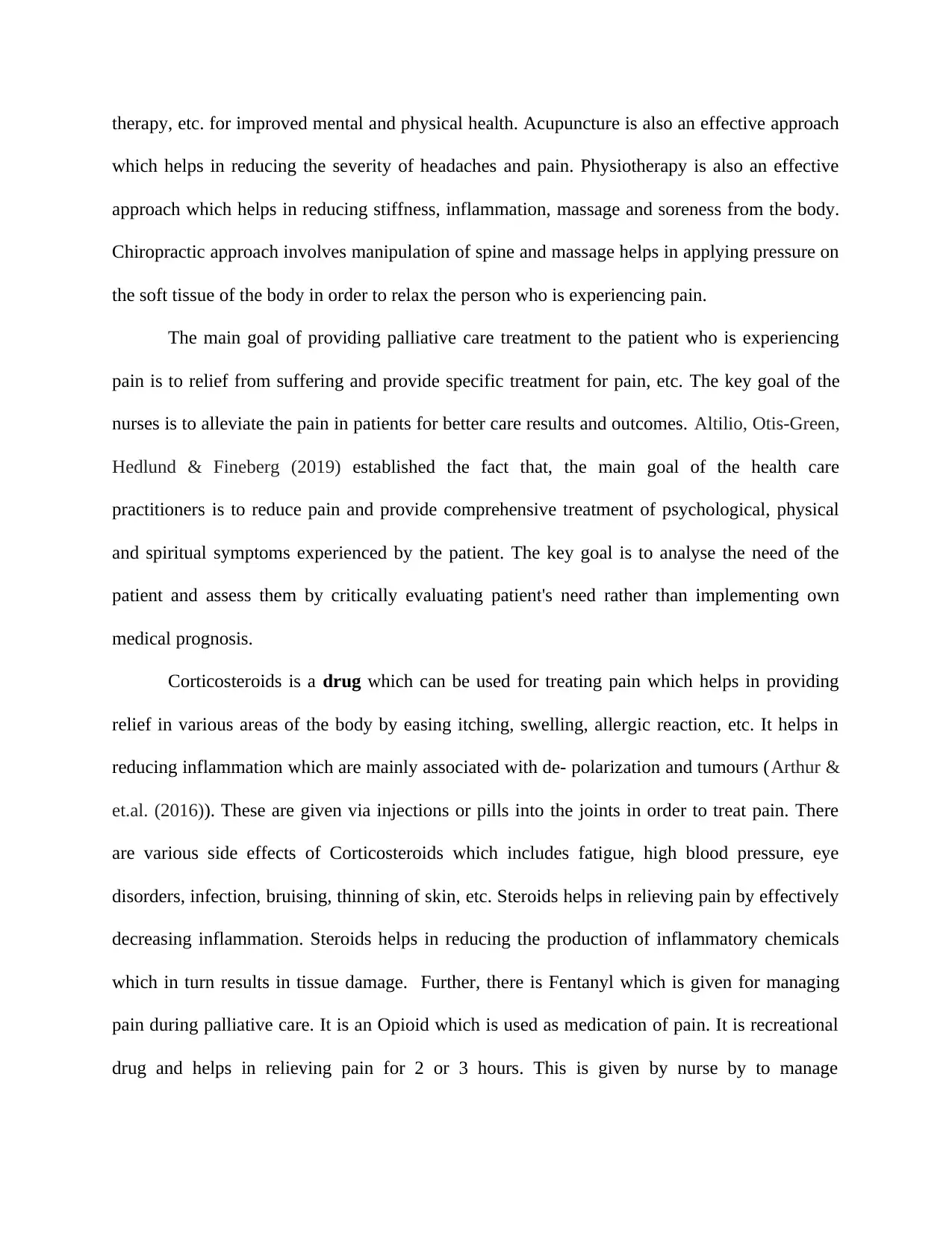
therapy, etc. for improved mental and physical health. Acupuncture is also an effective approach
which helps in reducing the severity of headaches and pain. Physiotherapy is also an effective
approach which helps in reducing stiffness, inflammation, massage and soreness from the body.
Chiropractic approach involves manipulation of spine and massage helps in applying pressure on
the soft tissue of the body in order to relax the person who is experiencing pain.
The main goal of providing palliative care treatment to the patient who is experiencing
pain is to relief from suffering and provide specific treatment for pain, etc. The key goal of the
nurses is to alleviate the pain in patients for better care results and outcomes. Altilio, Otis‐Green,
Hedlund & Fineberg (2019) established the fact that, the main goal of the health care
practitioners is to reduce pain and provide comprehensive treatment of psychological, physical
and spiritual symptoms experienced by the patient. The key goal is to analyse the need of the
patient and assess them by critically evaluating patient's need rather than implementing own
medical prognosis.
Corticosteroids is a drug which can be used for treating pain which helps in providing
relief in various areas of the body by easing itching, swelling, allergic reaction, etc. It helps in
reducing inflammation which are mainly associated with de- polarization and tumours (Arthur &
et.al. (2016)). These are given via injections or pills into the joints in order to treat pain. There
are various side effects of Corticosteroids which includes fatigue, high blood pressure, eye
disorders, infection, bruising, thinning of skin, etc. Steroids helps in relieving pain by effectively
decreasing inflammation. Steroids helps in reducing the production of inflammatory chemicals
which in turn results in tissue damage. Further, there is Fentanyl which is given for managing
pain during palliative care. It is an Opioid which is used as medication of pain. It is recreational
drug and helps in relieving pain for 2 or 3 hours. This is given by nurse by to manage
which helps in reducing the severity of headaches and pain. Physiotherapy is also an effective
approach which helps in reducing stiffness, inflammation, massage and soreness from the body.
Chiropractic approach involves manipulation of spine and massage helps in applying pressure on
the soft tissue of the body in order to relax the person who is experiencing pain.
The main goal of providing palliative care treatment to the patient who is experiencing
pain is to relief from suffering and provide specific treatment for pain, etc. The key goal of the
nurses is to alleviate the pain in patients for better care results and outcomes. Altilio, Otis‐Green,
Hedlund & Fineberg (2019) established the fact that, the main goal of the health care
practitioners is to reduce pain and provide comprehensive treatment of psychological, physical
and spiritual symptoms experienced by the patient. The key goal is to analyse the need of the
patient and assess them by critically evaluating patient's need rather than implementing own
medical prognosis.
Corticosteroids is a drug which can be used for treating pain which helps in providing
relief in various areas of the body by easing itching, swelling, allergic reaction, etc. It helps in
reducing inflammation which are mainly associated with de- polarization and tumours (Arthur &
et.al. (2016)). These are given via injections or pills into the joints in order to treat pain. There
are various side effects of Corticosteroids which includes fatigue, high blood pressure, eye
disorders, infection, bruising, thinning of skin, etc. Steroids helps in relieving pain by effectively
decreasing inflammation. Steroids helps in reducing the production of inflammatory chemicals
which in turn results in tissue damage. Further, there is Fentanyl which is given for managing
pain during palliative care. It is an Opioid which is used as medication of pain. It is recreational
drug and helps in relieving pain for 2 or 3 hours. This is given by nurse by to manage
⊘ This is a preview!⊘
Do you want full access?
Subscribe today to unlock all pages.

Trusted by 1+ million students worldwide
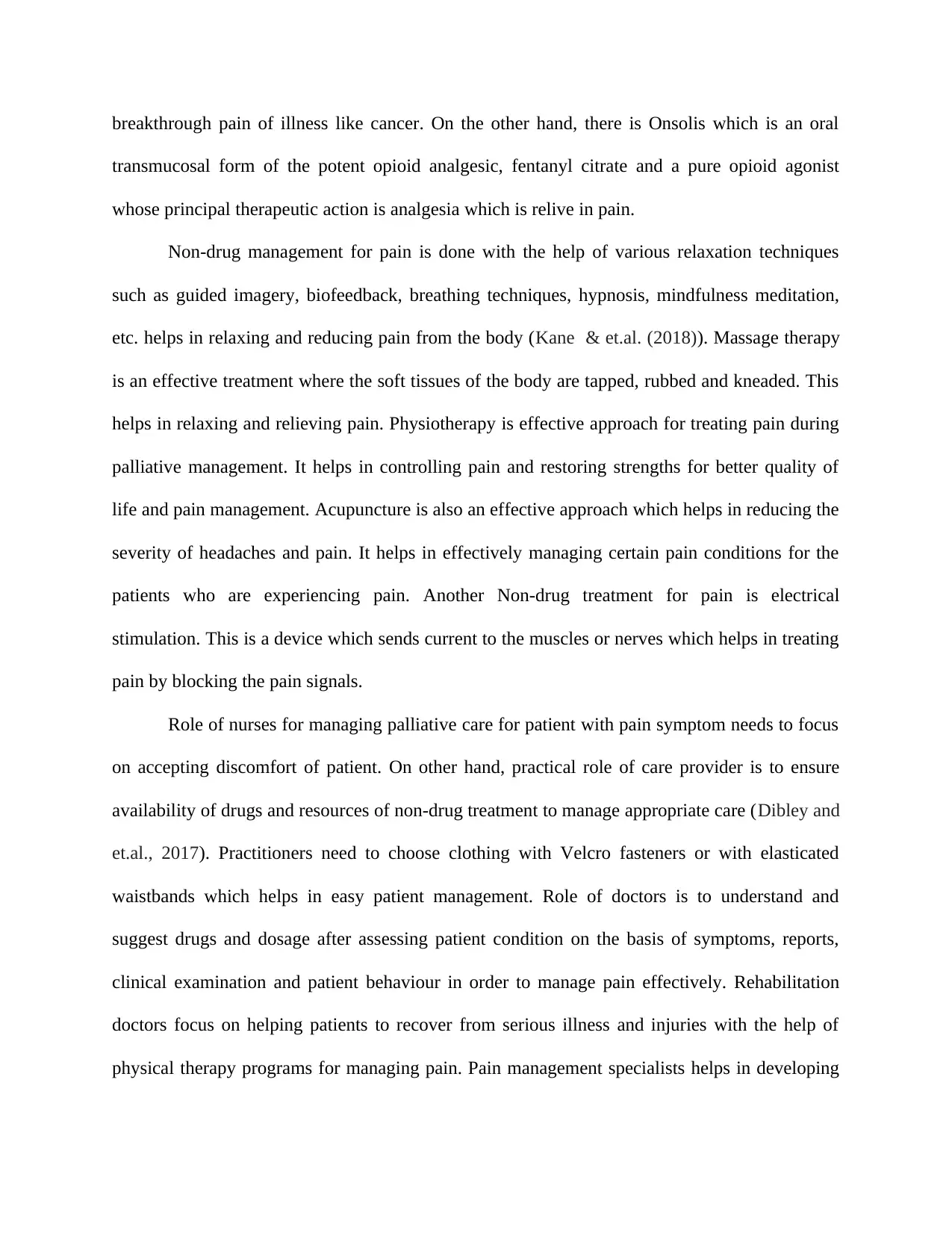
breakthrough pain of illness like cancer. On the other hand, there is Onsolis which is an oral
transmucosal form of the potent opioid analgesic, fentanyl citrate and a pure opioid agonist
whose principal therapeutic action is analgesia which is relive in pain.
Non-drug management for pain is done with the help of various relaxation techniques
such as guided imagery, biofeedback, breathing techniques, hypnosis, mindfulness meditation,
etc. helps in relaxing and reducing pain from the body (Kane & et.al. (2018)). Massage therapy
is an effective treatment where the soft tissues of the body are tapped, rubbed and kneaded. This
helps in relaxing and relieving pain. Physiotherapy is effective approach for treating pain during
palliative management. It helps in controlling pain and restoring strengths for better quality of
life and pain management. Acupuncture is also an effective approach which helps in reducing the
severity of headaches and pain. It helps in effectively managing certain pain conditions for the
patients who are experiencing pain. Another Non-drug treatment for pain is electrical
stimulation. This is a device which sends current to the muscles or nerves which helps in treating
pain by blocking the pain signals.
Role of nurses for managing palliative care for patient with pain symptom needs to focus
on accepting discomfort of patient. On other hand, practical role of care provider is to ensure
availability of drugs and resources of non-drug treatment to manage appropriate care (Dibley and
et.al., 2017). Practitioners need to choose clothing with Velcro fasteners or with elasticated
waistbands which helps in easy patient management. Role of doctors is to understand and
suggest drugs and dosage after assessing patient condition on the basis of symptoms, reports,
clinical examination and patient behaviour in order to manage pain effectively. Rehabilitation
doctors focus on helping patients to recover from serious illness and injuries with the help of
physical therapy programs for managing pain. Pain management specialists helps in developing
transmucosal form of the potent opioid analgesic, fentanyl citrate and a pure opioid agonist
whose principal therapeutic action is analgesia which is relive in pain.
Non-drug management for pain is done with the help of various relaxation techniques
such as guided imagery, biofeedback, breathing techniques, hypnosis, mindfulness meditation,
etc. helps in relaxing and reducing pain from the body (Kane & et.al. (2018)). Massage therapy
is an effective treatment where the soft tissues of the body are tapped, rubbed and kneaded. This
helps in relaxing and relieving pain. Physiotherapy is effective approach for treating pain during
palliative management. It helps in controlling pain and restoring strengths for better quality of
life and pain management. Acupuncture is also an effective approach which helps in reducing the
severity of headaches and pain. It helps in effectively managing certain pain conditions for the
patients who are experiencing pain. Another Non-drug treatment for pain is electrical
stimulation. This is a device which sends current to the muscles or nerves which helps in treating
pain by blocking the pain signals.
Role of nurses for managing palliative care for patient with pain symptom needs to focus
on accepting discomfort of patient. On other hand, practical role of care provider is to ensure
availability of drugs and resources of non-drug treatment to manage appropriate care (Dibley and
et.al., 2017). Practitioners need to choose clothing with Velcro fasteners or with elasticated
waistbands which helps in easy patient management. Role of doctors is to understand and
suggest drugs and dosage after assessing patient condition on the basis of symptoms, reports,
clinical examination and patient behaviour in order to manage pain effectively. Rehabilitation
doctors focus on helping patients to recover from serious illness and injuries with the help of
physical therapy programs for managing pain. Pain management specialists helps in developing
Paraphrase This Document
Need a fresh take? Get an instant paraphrase of this document with our AI Paraphraser

treatment plan for reliving and managing pain (The Role of Health Professionals, 2019). This
helps patient perform task without any reliance of specific medication and surgery. Internists
focus on managing pain by diagnosing patient condition and preventing pain. Psychologists
focuses on emotions, behaviour and various social factors for palliative care management. It
focuses on using non- drug approach to manage pain of the patient. Bereavement counsellors are
effectively trained in order to provide support to the people who are experiencing grief.
ROLE OF SUPPORTIVE INTERVENTIONS IN PALLATIVE
MANAGEMENT FOR PAIN MANAGEMENT
Relaxation of muscles by involving patient in physiotherapy is an effective nursing
intervention which strengthens the muscles. According to Pedraza and et.al., (2014), it is an
appropriate intervention which strengthen the muscles and helps in managing pain. It consists of
6 possible therapeutic modal tie down-training, accessory muscle isolation, discrimination
training, muscle strengthening, endurance training and electrical stimulation. The role of nurse in
this therapy is to patient function as independently as possible.
Cognitive behaviour therapy is a suitable nursing intervention for pain management in end
of life care unit. In this role of nurse is to enhance community care of patient against emotional
mental illness. The approach helps in reliving patient from mental distress which is essential to
gain individual trust and confidence over own condition (Urden, Stacy, & Lough. (2017)).
Cognitive behaviour therapy is very useful in changing the emotion, thoughts and behaviour of
the individual related to the pain. It helps in improving effective strategies which helps in
improving the quality of care.
Education of patient in palliative care unit about pain management play an essential role in
increasing involvement of service user in controlling and presenting feelings in front of care
helps patient perform task without any reliance of specific medication and surgery. Internists
focus on managing pain by diagnosing patient condition and preventing pain. Psychologists
focuses on emotions, behaviour and various social factors for palliative care management. It
focuses on using non- drug approach to manage pain of the patient. Bereavement counsellors are
effectively trained in order to provide support to the people who are experiencing grief.
ROLE OF SUPPORTIVE INTERVENTIONS IN PALLATIVE
MANAGEMENT FOR PAIN MANAGEMENT
Relaxation of muscles by involving patient in physiotherapy is an effective nursing
intervention which strengthens the muscles. According to Pedraza and et.al., (2014), it is an
appropriate intervention which strengthen the muscles and helps in managing pain. It consists of
6 possible therapeutic modal tie down-training, accessory muscle isolation, discrimination
training, muscle strengthening, endurance training and electrical stimulation. The role of nurse in
this therapy is to patient function as independently as possible.
Cognitive behaviour therapy is a suitable nursing intervention for pain management in end
of life care unit. In this role of nurse is to enhance community care of patient against emotional
mental illness. The approach helps in reliving patient from mental distress which is essential to
gain individual trust and confidence over own condition (Urden, Stacy, & Lough. (2017)).
Cognitive behaviour therapy is very useful in changing the emotion, thoughts and behaviour of
the individual related to the pain. It helps in improving effective strategies which helps in
improving the quality of care.
Education of patient in palliative care unit about pain management play an essential role in
increasing involvement of service user in controlling and presenting feelings in front of care

providers. This helps in integration with patient helps in making individual comfortable with the
condition (Hui & Bruera (2016)). In this role of nurse is to share detail of condition and symptom
with treatment measures. This is supportive because it encourages patient involvement increase
planning which leads to improvement.
Psychotherapeutic approach helps in improving the social, emotional, physical and
occupational functioning in order to effectively resolve pain of an individual. It helps in
changing problematic feeling and behaviour of an individual. This intervention leads to effective
communication between the therapist and the patient for better quality of life. Guided imagery
helps in providing relief from painful conditions such as arthritis. It helps in easing stress and
improving physical condition of the individual suffering from pain.
Biofeedback is an effective nursing intervention which helps in treating chronic pain with
the help of relaxation techniques (Lilley & et.al. (2016).). It helps in identifying tight muscles
and effectively relieve the muscles in order to reduce pain. Relaxation techniques such as
foursquare breathing helps in reducing pain by providing effective palliative care.
CONCLUSION
The essay summarized about the symptoms of palliative care which is pain management.
The study outlined impact, nature, prevalence and characteristics of symptom. Also, study
concluded with reviews of different authors over assessment, approaches, drugs and non-
treatment management of pain in Palliative care. Hence, it concluded with outlined the role of
supportive intervention for managing suitable care of chosen symptom.
condition (Hui & Bruera (2016)). In this role of nurse is to share detail of condition and symptom
with treatment measures. This is supportive because it encourages patient involvement increase
planning which leads to improvement.
Psychotherapeutic approach helps in improving the social, emotional, physical and
occupational functioning in order to effectively resolve pain of an individual. It helps in
changing problematic feeling and behaviour of an individual. This intervention leads to effective
communication between the therapist and the patient for better quality of life. Guided imagery
helps in providing relief from painful conditions such as arthritis. It helps in easing stress and
improving physical condition of the individual suffering from pain.
Biofeedback is an effective nursing intervention which helps in treating chronic pain with
the help of relaxation techniques (Lilley & et.al. (2016).). It helps in identifying tight muscles
and effectively relieve the muscles in order to reduce pain. Relaxation techniques such as
foursquare breathing helps in reducing pain by providing effective palliative care.
CONCLUSION
The essay summarized about the symptoms of palliative care which is pain management.
The study outlined impact, nature, prevalence and characteristics of symptom. Also, study
concluded with reviews of different authors over assessment, approaches, drugs and non-
treatment management of pain in Palliative care. Hence, it concluded with outlined the role of
supportive intervention for managing suitable care of chosen symptom.
⊘ This is a preview!⊘
Do you want full access?
Subscribe today to unlock all pages.

Trusted by 1+ million students worldwide
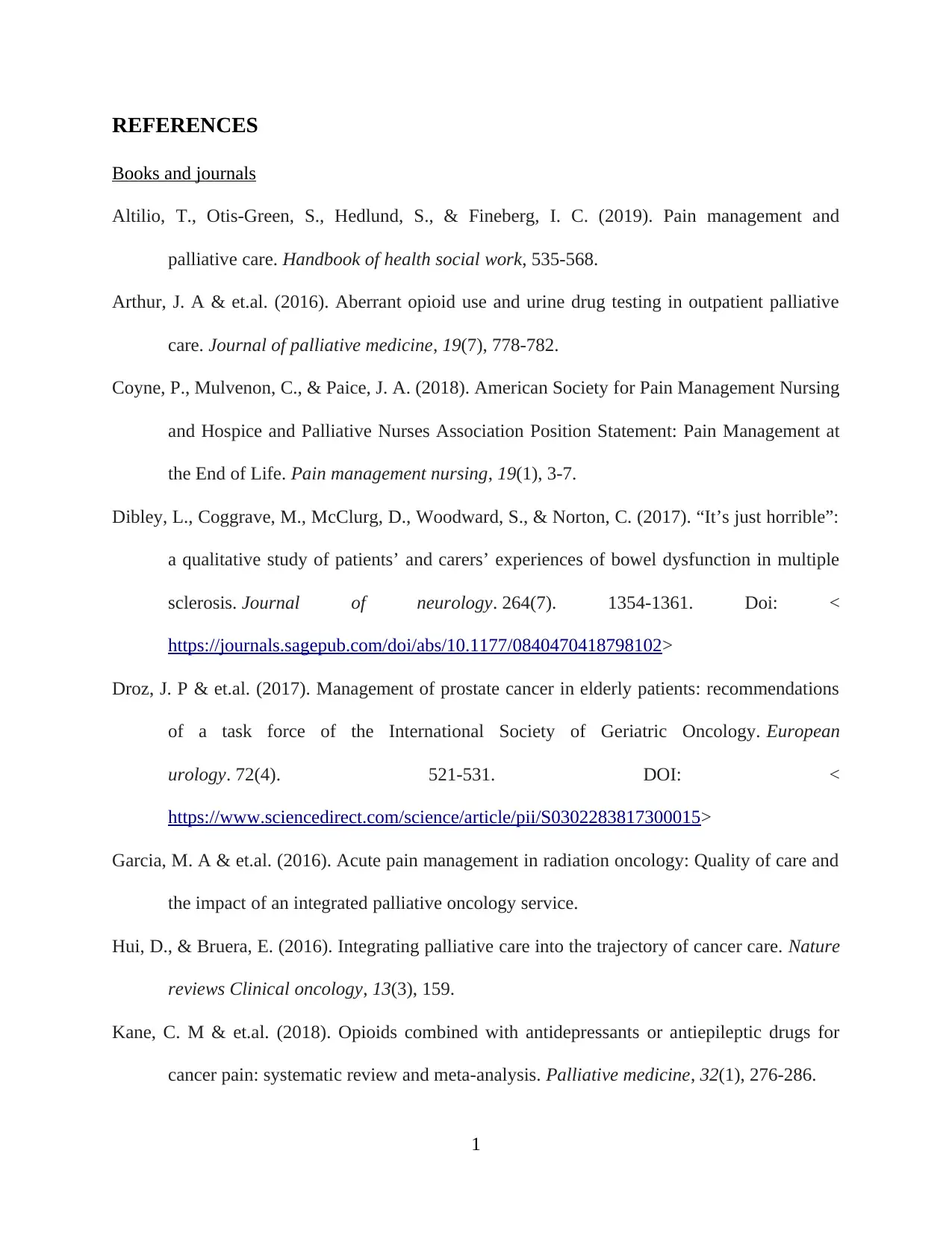
REFERENCES
Books and journals
Altilio, T., Otis‐Green, S., Hedlund, S., & Fineberg, I. C. (2019). Pain management and
palliative care. Handbook of health social work, 535-568.
Arthur, J. A & et.al. (2016). Aberrant opioid use and urine drug testing in outpatient palliative
care. Journal of palliative medicine, 19(7), 778-782.
Coyne, P., Mulvenon, C., & Paice, J. A. (2018). American Society for Pain Management Nursing
and Hospice and Palliative Nurses Association Position Statement: Pain Management at
the End of Life. Pain management nursing, 19(1), 3-7.
Dibley, L., Coggrave, M., McClurg, D., Woodward, S., & Norton, C. (2017). “It’s just horrible”:
a qualitative study of patients’ and carers’ experiences of bowel dysfunction in multiple
sclerosis. Journal of neurology. 264(7). 1354-1361. Doi: <
https://journals.sagepub.com/doi/abs/10.1177/0840470418798102>
Droz, J. P & et.al. (2017). Management of prostate cancer in elderly patients: recommendations
of a task force of the International Society of Geriatric Oncology. European
urology. 72(4). 521-531. DOI: <
https://www.sciencedirect.com/science/article/pii/S0302283817300015>
Garcia, M. A & et.al. (2016). Acute pain management in radiation oncology: Quality of care and
the impact of an integrated palliative oncology service.
Hui, D., & Bruera, E. (2016). Integrating palliative care into the trajectory of cancer care. Nature
reviews Clinical oncology, 13(3), 159.
Kane, C. M & et.al. (2018). Opioids combined with antidepressants or antiepileptic drugs for
cancer pain: systematic review and meta-analysis. Palliative medicine, 32(1), 276-286.
1
Books and journals
Altilio, T., Otis‐Green, S., Hedlund, S., & Fineberg, I. C. (2019). Pain management and
palliative care. Handbook of health social work, 535-568.
Arthur, J. A & et.al. (2016). Aberrant opioid use and urine drug testing in outpatient palliative
care. Journal of palliative medicine, 19(7), 778-782.
Coyne, P., Mulvenon, C., & Paice, J. A. (2018). American Society for Pain Management Nursing
and Hospice and Palliative Nurses Association Position Statement: Pain Management at
the End of Life. Pain management nursing, 19(1), 3-7.
Dibley, L., Coggrave, M., McClurg, D., Woodward, S., & Norton, C. (2017). “It’s just horrible”:
a qualitative study of patients’ and carers’ experiences of bowel dysfunction in multiple
sclerosis. Journal of neurology. 264(7). 1354-1361. Doi: <
https://journals.sagepub.com/doi/abs/10.1177/0840470418798102>
Droz, J. P & et.al. (2017). Management of prostate cancer in elderly patients: recommendations
of a task force of the International Society of Geriatric Oncology. European
urology. 72(4). 521-531. DOI: <
https://www.sciencedirect.com/science/article/pii/S0302283817300015>
Garcia, M. A & et.al. (2016). Acute pain management in radiation oncology: Quality of care and
the impact of an integrated palliative oncology service.
Hui, D., & Bruera, E. (2016). Integrating palliative care into the trajectory of cancer care. Nature
reviews Clinical oncology, 13(3), 159.
Kane, C. M & et.al. (2018). Opioids combined with antidepressants or antiepileptic drugs for
cancer pain: systematic review and meta-analysis. Palliative medicine, 32(1), 276-286.
1
Paraphrase This Document
Need a fresh take? Get an instant paraphrase of this document with our AI Paraphraser

Kelley, A. S., & Morrison, R. S. (2015). Palliative care for the seriously ill. New England
Journal of Medicine, 373(8), 747-755.
Lilley, E. J & et.al. (2016). Palliative care interventions for surgical patients: a systematic
review. JAMA surgery, 151(2), 172-183.
Pedraza, R., Nieto, J., Ibarra, S., & Haas, E. M. (2014). Pelvic muscle rehabilitation: a
standardized protocol for pelvic floor dysfunction. Advances in urology. 2014. DOI: <
https://www.hindawi.com/journals/au/2014/487436/>
Urden, L. D., Stacy, K. M., & Lough, M. E. (2017). Critical Care Nursing-E-Book: Diagnosis
and Management. Elsevier Health Sciences.
Online
Is pain affecting your quality of life? Palliative care can help. 2016. [Online]. Available through:
<https://getpalliativecare.org/palliative-care-pain-management/>
The Role of Health Professionals. 2019. [Online]. Available through:
<https://www.caresearch.com.au/caresearch/ForPatientsandFamilies/AboutPalliativeCare/
WhoProvidesPalliativeCare/TheRoleofHealthProfessionals/tabid/954/Default.aspx>
2
Journal of Medicine, 373(8), 747-755.
Lilley, E. J & et.al. (2016). Palliative care interventions for surgical patients: a systematic
review. JAMA surgery, 151(2), 172-183.
Pedraza, R., Nieto, J., Ibarra, S., & Haas, E. M. (2014). Pelvic muscle rehabilitation: a
standardized protocol for pelvic floor dysfunction. Advances in urology. 2014. DOI: <
https://www.hindawi.com/journals/au/2014/487436/>
Urden, L. D., Stacy, K. M., & Lough, M. E. (2017). Critical Care Nursing-E-Book: Diagnosis
and Management. Elsevier Health Sciences.
Online
Is pain affecting your quality of life? Palliative care can help. 2016. [Online]. Available through:
<https://getpalliativecare.org/palliative-care-pain-management/>
The Role of Health Professionals. 2019. [Online]. Available through:
<https://www.caresearch.com.au/caresearch/ForPatientsandFamilies/AboutPalliativeCare/
WhoProvidesPalliativeCare/TheRoleofHealthProfessionals/tabid/954/Default.aspx>
2

3
⊘ This is a preview!⊘
Do you want full access?
Subscribe today to unlock all pages.

Trusted by 1+ million students worldwide
1 out of 12
Related Documents
Your All-in-One AI-Powered Toolkit for Academic Success.
+13062052269
info@desklib.com
Available 24*7 on WhatsApp / Email
![[object Object]](/_next/static/media/star-bottom.7253800d.svg)
Unlock your academic potential
Copyright © 2020–2025 A2Z Services. All Rights Reserved. Developed and managed by ZUCOL.





